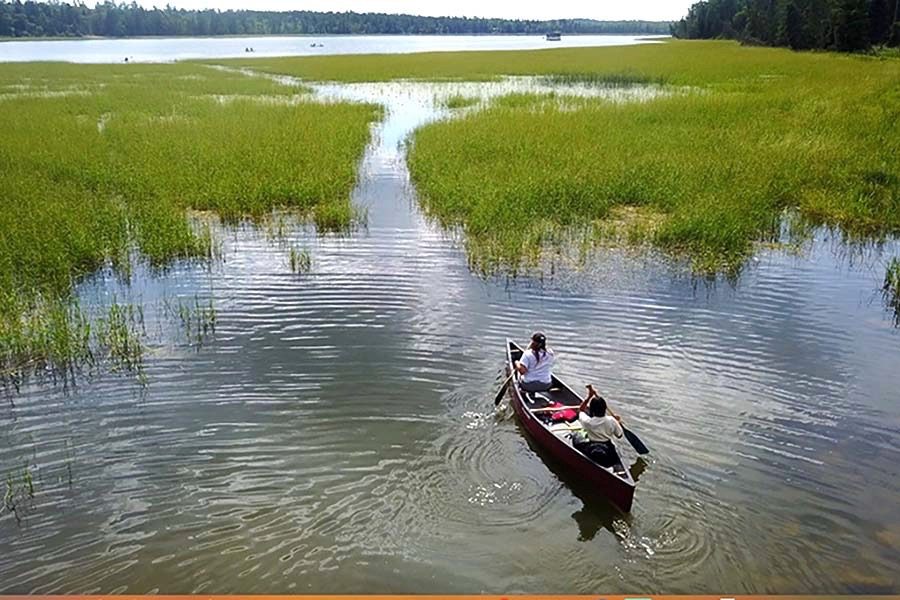If we don’t stop Line 3, the next Standing Rock could be in Minnesota
Photo courtesy of Rose Whipple
One way that the resistance to Line 3 has been growing is through involvement of indigenous youth. In August, a group of them organized a canoe trip called “Paddle to Protect,” in which they paddled 250 miles to raise awareness about the sacredness of land and water to their culture.
Since the fight against the Dakota Access Pipeline culminated in the months-long resistance camp at Standing Rock in 2016, opposition to oil pipelines across the U.S. has been growing. Currently, one very prominent pipeline fight is happening in Minnesota against Enbridge Energy Company’s proposed Line 3. This pipeline is proposed to cross northern Minnesota, carrying tar sands oil from Alberta, Canada, to Superior WI. The resistance to Line 3 is surging, and it is critical that everyone join the fight.
On November 1st, legal hearings on Line 3 began at the Public Utilities Commission (PUC) in St. Paul. There Enbridge is defending their project before a judge, and intervening parties are making their case against it. The judge will make a recommendation in February, and the PUC will make its final decision to approve or deny the pipeline in April.
Along with the legal efforts against Line 3, the opposition is growing at sites along the proposed route. Three camps have been established, each similar to Standing Rock: Camp Ma’iingan, a prayer camp; Camp Makwa, a non-violent resistance camp; and Camp Turtle Island, the base camp for the front-line fight.
Bill Paulson (also known as Bezig Biosh), the leader of Camp Turtle Island, explained, “[The campers] are currently here to support… day-to-day movement against the pipeline. If the permitting process is approved for Enbridge… we’ll go up and stand the line.”
It’s easy to see why stopping Line 3 is so important to Paulson, who is a member of the Crane Clan and the White Earth Nation. Line 3 would violate treaty rights and threaten wild rice, thus harming Anishinaabe culture directly.
Wild rice is important to the Anishinaabe people for many reasons. Most importantly, it’s key to Anishinaabe history. “It’s the reason we live [in Minnesota],” Paulson said. “Through prophecy we were told to migrate to the area where the good berry and manoomin [wild rice] grew on the water. And if we took care of the wild rice, it would take care of us.”
Today, wild rice is central to spiritual tradition and ceremony. As senior Leticia Leon explained, “Harvesting season is a tradition… going out and collecting wild rice as a tribe is something that all the tribes in [Minnesota] do every year.”
Additionally, wild rice helps many tribal members economically. “My uncle literally makes half his yearly money ricing… the economic impact of losing the rice would be devastating to the tribes,” said All Nations social studies teacher Vincent Patton.
It’s clear that losing the wild rice is a huge deal and would be devastating for many indigenous communities. “If we lose the wild rice paddies, that’s basically like a Christian losing their cross, or a [Muslim] losing their hijab… that’s part of our culture, and it’s been there for a while,” said junior Dylan Halberg.
As Paulson described, “If the wild rice disappears, we’ll disappear as a people. That spirit of the wild rice gives us the gift of life.”
Furthermore, the pipeline would also violate treaty rights. Though Line 3 would not actually cross any reservations, it would go through a substantial treaty area where Anishinaabe people have the right to hunt, fish and gather that extends beyond reservation boundaries. The pipeline would violate the treaty by harming the sacred resources promised to the native people on these lands.
Broken treaties represent a longstanding pattern of racism and ignorance of indigenous cultures by European settlers and their descendants. Of the 500+ treaties signed in the U.S., not one has been fully upheld. Each additional broken treaty adds to the historical trauma that Native people have experienced.
“What I see is the corporate world and western society believing that the Native Americans are an entity that can be ignored,” Paulson said. “Putting in pipelines and transporting oil is the [corporate] way of life, and…. they look for every governmental loophole to not acknowledge Native Americans, that we’re here.”
Nonetheless, there is still hope. Since Standing Rock, indigenous groups have become more united and powerful. “Native Americans stick together, and once they see a problem they do speak up,” Leon said.
Though Standing Rock is over, the movement of “water protectors” led by indigenous groups is continuing to grow. As Paulson declared, “People are waking up. As Native American people we can come past our historical trauma and act as one… and it transcends every color.”
But will this be enough? According to Leon, “People are hearing us… [and] they say they’re supporting us but they’re not supporting us to the fullest.” To stop Line 3, this movement needs even greater engagement.
There is still time to submit public comment against Line 3 before a November 22nd deadline. Your comments can be as simple as urging the PUC judge to deny the pipeline, and should be emailed to publicadvisor.puc@state.mn.us. There are many injustices at play here, therefore it’s crucial that everyone raise their voice in opposition Line 3 and all that it stands for.

As she begins her second year as Opinions editor and 3rd year on the newspaper staff, Sophia Manolis is more dedicated than ever to make sure new and returning...










Katharine Skibbe • Nov 14, 2017 at 8:54 pm
So informative and well written. Thank you, Sophie!